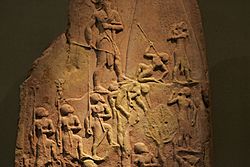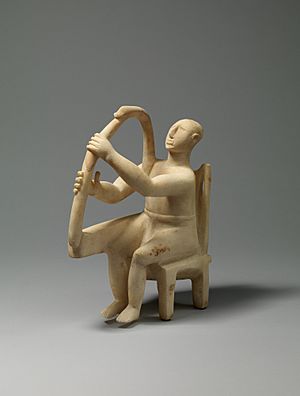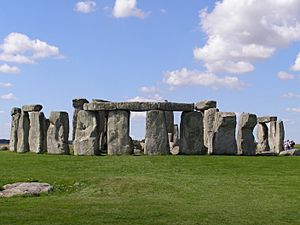3rd millennium BC facts for kids
| Millennia: | 4th millennium BC · 3rd millennium BC · 2nd millennium BC |
| Centuries: | 30th century BC · 29th century BC · 28th century BC · 27th century BC · 26th century BC · 25th century BC · 24th century BC · 23rd century BC · 22nd century BC · 21st century BC |
The 3rd millennium BC spans the Early to Middle Bronze Age.
This was a period of time in which the desire to conquer was common. Expansion occurred throughout the Middle East and throughout Eurasia, with Indo-European expansion to Anatolia, Europe and Central Asia. The civilization of Ancient Egypt rose to a peak with the Old Kingdom. World population is estimated to have doubled in the course of the millennium to 30 million people.
Contents
Cultures
- Near East
- c. 2900–2350 BC: Early Dynastic Period (Mesopotamia)
- c. 2334–2154 BC: Akkadian Empire
- 3100–2686 BC: Early Dynastic Period (Egypt)
- c. 2700 BC–1600 BC: Old Elamite period.
- 2686–2181 BC Old Kingdom of Egypt
- 2181–2055 BC First Intermediate Period of Egypt
- c. 3000 BC: Nubian A-Group Culture comes to an end.
- c. 2300 BC: Nubian C-Group culture.
- Europe
- Further information: Neolithic Europe
- c. 3200 BC: Cycladic culture in Aegean islands of Greece.
- c. 3200 BC–3100 BC: Helladic culture in mainland Greece.
- c. 3200 BC–2800 BC: Ozieri culture.
- Founding of Europe's oldest civilization, the Minoan Civilization in 3000 BC.
- Corded Ware culture (also Battle-axe culture, or Single Grave culture).
- Late Maikop culture.
- Late Vinca culture.
- Globular Amphora culture.
- Early Beaker culture.
- Yamnaya culture, Catacomb culture, likely loci of Indo-European Satemization.
- The Sintashta-Petrovka-Arkaim culture emerges from the Catacomb culture from about 2200 BC, likely locus of Proto-Indo-Iranian.
- Butmir culture.
- Late Funnelbeaker culture.
- Baden culture.
- Gaudo culture.
- South Asia
- 2800 BC–2600 BC: Harappan 2.
- 2600 BC–1900 BC: Harappan 3 (Mature Harappan).
- East and Southeast Asia
- Longshan culture
- Baodun culture
- Shijiahe culture
- Liangzhu culture
- Majiayao culture
- Lower Xiajiadian culture
- c. 2500 BC: Austronesian peoples from Formosa colonize Luzon in northern Philippines.
- Americas
- Mesoamerican Archaic period
- Old Copper Complex
- Caral/Norte Chico civilization.
- Sub-Saharan Africa
- Savanna Pastoral Neolithic
- Elmenteitan
Events
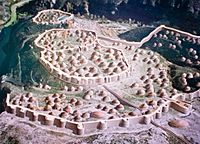
A model of the prehistoric town of Los Millares, with its walls.
Certain 4th millennium BC events were precursors to the 3rd millennium BC:
- c. 3700 BC: Lothal: Indus Valley trade-port city in India.
- c. 3650 BC–3000 BC: Minoan culture appeared on Crete.
- c. 3200 BC/3100 BC: Helladic culture and Cycladic culture both emerge in Greece.
The 3rd millennium BC included the following key events:
- c. 3000 BC: Unification of Upper and Lower Egypt.
- c. 3000 BC: First evidence of gold being used in the Middle East.
- c. 3000 BC: Nubian A-Group, Ta-Seeti "kingdom" came to an end, possibly due to raids by Egypt.
- c. 3000 BC–2000 BC: Vessels from Denmark are made; they are now at National Museum, Copenhagen.
- c. 2890 BC: Second Dynasty of Egypt, reign of Hotepsekhemwy.
- Syria: Foundation of the city of Mari (29th century BC).
- Semitic tribes occupy Assyria in northern part of the plain of Shinar and Akkad.
- Phoenicians settle on Syrian coast, with centers at Tyre and Sidon.
- Beginning of the period of the mythical Sage Kings in China, also known as the Three Sovereigns and Five Emperors.
- c. 2879 BC: Rise of the mythical Văn Lang Kingdom and the Hồng Bàng Dynasty in northern Viet Nam.
- c. 2800 BC–2700 BC: Harp Player, from Keros, Cyclades, was made. It is now at the Metropolitan Museum of Art, New York.
- Iran: Creation of the Kingdom of Elam.
- Germination of the Bristlecone pine tree "Methuselah" about 2700 BC, one of the oldest known trees still living now.
- c. 2686 BC: Third Dynasty of Egypt, reign of Sanakhte.
- c. 2613 BC: Fourth Dynasty of Egypt, reign of Sneferu.
- c. 2600 BC: Founding of the Chalcolithic Iberian civilizations of Los Millares and Zambujal.
- 2600 BC: Unified Indus Valley Civilisation.
- c. 2500 BC: The state of Assyria is established.
- c. 2500 BC: Excavation and development of the Hypogeum of Ħal-Saflieni at Paola, Malta, a subterranean temple complex subsequently used as a necropolis.
- c. 2500 BC–2200 BC: Incised panel "Frying pan", from Syros, Cyclades is made; it is now at the National Archaeological Museum, Athens.
- c. 2500 BC–2200 BC: Two figures of women, from the Cyclades, are made; they are now at Museum of Cycladic Art, Athens.
- Dynasty of Lagash in Sumer.
- 2474 BC–2398 BC: Golden age of Ur in Mesopotamia.
- c. 2498 BC: Fifth Dynasty of Egypt, reign of Userkaf.
- c. 2492 BC: The Armenian patriarch Hayk defeats the Babylonian king Bel (legendary account).
- c. 2345 BC: Sixth Dynasty of Egypt, reign of Teti.
- 2334 BC: Sargon of Akkad conquers Mesopotamia, establishing the Akkadian Empire.
- c. 2300 BC: C-Group pastoralists arrive in Nubia.
- c. 2181 BC: Seventh and Eighth Dynasty of Egypt (2181–2160).
- c. 2160 BC: Ninth Dynasty of Egypt, reign of Akhtoy Meryibtowe.
- c. 2130 BC: Tenth Dynasty of Egypt, reign of Meryhathor.
- c. 2134 BC: Eleventh Dynasty of Egypt, reign of Mentuhotep I.
- Megalithic, Corded Ware culture and the Beaker flourish in Europe.
- Sumerian poetry, lamenting the death of Tammuz, the shepherd god.
- Sumerian cuneiform writing (reduces pictographs still in use to about 550 BC).
- Major religious festival in Sumeria celebrates victory of god of spring over goddess of chaos.
- Earliest Trojan culture.
- Glass beads in Egypt.
- Beginning of the Pengtoushan culture in China.
- The world's last surviving mammoth population, on Wrangel Island in the Arctic Ocean, goes extinct, sometime between 2500 and 2000 BC.
- c. 2070 BC–1600 BC: The legendary Xia Dynasty in China.
Significant people
- Imhotep, first known architect, physician and engineer in Ancient history.
- The Three Sovereigns and Five Emperors of China.
- Djoser, king of Egypt, commissions the Step Pyramid at Saqqara.
- Gilgamesh, fifth king of the First Dynasty of Uruk, immortalized in the world's first literary work the Epic of Gilgamesh (c. 26th century BC).
- Khufu, king of Egypt, builder of the Great Pyramid of Giza.
- Urukagina, king of Lagash, creates the first known judicial code (24th century BC).
- Lugalsaggizi, king of Uruk and Umma conquers Lagash (2371 BC–2347 BC).
- Sargon the Great, founder of the empire of Akkad and Sumer (2371 BC–2316 BC middle chronology).
- Ur-Nammu founder of the 3rd dynasty of Ur (2112 BC–2095 BC middle chronology).
Inventions, discoveries, introductions
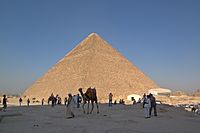
Great Pyramid of Giza, Kheops.
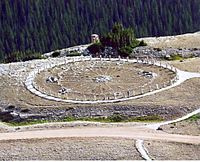
The Medicine Wheel in Bighorn National Forest, Wyoming, United States.
- c. 3500 BC: Indus script develops in Indus Valley Civilization.
- Pottery develops in Americas (30th century BC).
- c. 3000 BC: Potter's wheel appears in Mesopotamia.
- 2900 BC–2400 BC: Sumerians invent phonogram (linguistics).
- 2650 BC: Reservoirs, script, metals and pottery used in the city of Dholavira in Indus Valley Civilization.
- c. 2300 BC: Metals are used in Northern Europe.
- Chinese record a comet.
- Building of the Great Pyramid of Giza (26th century BC).
- Sails used on ships (20th century BC).
- First ziggurats built in Sumer.
- Near East civilizations enter Bronze Age around 3000 BC.
- Oldest known medicine wheel constructed in the Americas.
- First Copper (~2500 BC) and then Bronze (~2000 BC) and other types of metallurgy are introduced to Ireland.
- Domestication of the horse with the coming of Indo-Europeans in central Eurasia.
- The chariot emerges in Eurasian Steppe just before 2000 BC.
- The camel (dromedary) domesticated (though widespread use took until mid-to-late 2nd millennium BC).
- Indoor plumbing and sewage in the Indus Valley Civilization.
- Sumerian medicine discovers the healing qualities of mineral springs.
- Weaving loom known in Europe.
- Sumerian numerical system based on multiples of 6 and 12.
- Egyptians begin use of papyrus.
- Austronesian peoples have developed lateen sail, and the out-rigger as well as extensive development of celestial navigation systems.
Cultural landmarks
- c. 3000 BC–2500 BC: Tomb, Newgrange, Ireland, was built.
- c. 2750 BC–1500 BC: Stonehenge, Salisbury Plain, Wiltshire, England, is built.
- Completion of the Great Pyramid of Giza.
- Completion of first phase of Stonehenge monument in England.
- Era of Buena Vista pyramid/observatory in Peru.
- The Sydney rock engravings in Sydney, Australia, which are examples of Aboriginal rock art, date from around 3000 BC.
See also
 In Spanish: III milenio a. C. para niños
In Spanish: III milenio a. C. para niños

All content from Kiddle encyclopedia articles (including the article images and facts) can be freely used under Attribution-ShareAlike license, unless stated otherwise. Cite this article:
3rd millennium BC Facts for Kids. Kiddle Encyclopedia.

